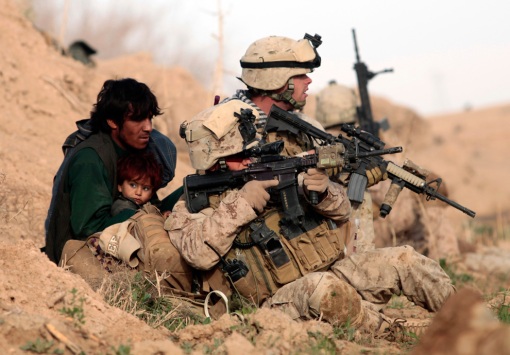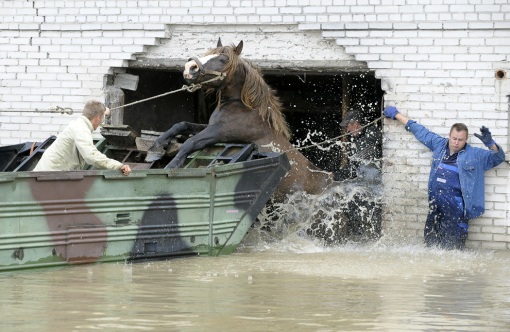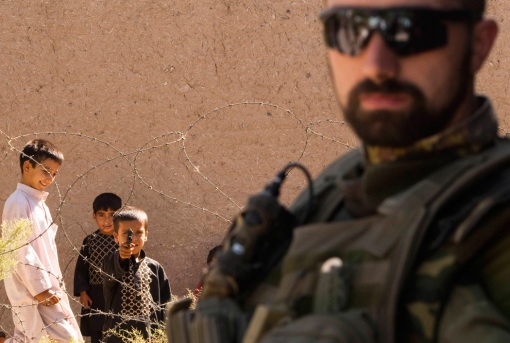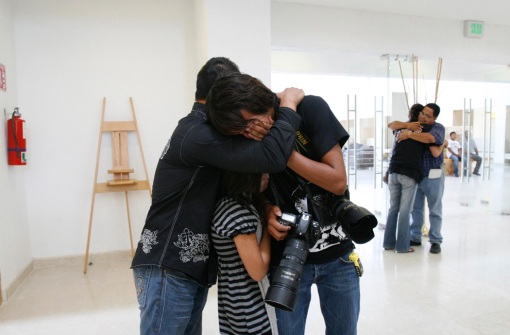I’ve decided I really, really like photos.
Part of this might be because I just bought a really cool new camera and have digital imaging on the mind. But despite my passion for words and my staunch belief that some things can only be expressed through the written word, I am constantly reminded of the power just one photograph can have. So when I saw a 2010 in Photos compilation on the Boston Globe’s website, boston.com, I just had to respond.
This three-part series captured 120 of the best photos from 2010. I contacted Alan Taylor, the web developer for boston.com and creator of the Big Picture blog, to ask him how these 120 made the cut. He said some of the photos had been featured earlier this year on the photo blog, while others had been cited as top 2010 images by Reuters, AFP or AP.
“Basically if a photograph was really good — exceptionally evocative, or beautiful or moving or arresting — or if it was very representative of a big or important news story, the photo was considered,” Taylor added. “It’s very subjective, and I try to balance my choices between aesthetics and journalism. It’s so rare to have a photo that is both very newsworthy and gorgeous.”
I picked just a few of the photos that caught my attention most to display here. I reordered them so they were in chronological order. I did not take any of them, and I don’t own any of them. I kept all of the original captions and attributions, although if you see a parenthetical addition, I put that there for clarity’s sake. All of the photos can be found at the original post — parts 1, 2 and 3.

A young Haitian man cries out in pain as his mother comforts him while being treated for a trauma wound on his arm at the Center Hospitalier de la Renaissance January 20, 2010 in Port-au-Prince, Haiti. Patients are being treated on the grounds of the hospital by Cuban and German doctors due to fears of the building's structural integrity. (Win McNamee/Getty Images)
The earthquake that shook Port-au-Prince, Haiti, on Jan. 12, 2010 was worldwide news for months, but despite the constant updates and statistics, it’s photos like this one that really brought the devastation the people of Haiti experienced to life in a personal way. Reading or hearing that hundreds of people died is powerful in its own way, but seeing a photo like this that actually captures the pain a young man is experiencing, and the pain it is causing his mother, touches those of us who are thousands of miles away in a more intimate way.

A man touches his newborn baby, born three days earlier, at the Israeli hospital in Port-au-Prince January 20, 2010. (REUTERS/Carlos Garcia Rawlins)
This photo, taken in Port-au-Prince on the same day, starkly contrasts with the previous one and offers a sense of hope. Despite the devastation, the thousands of people who were killed and injured and the rebuilding that needed to take place in the lives of those who remained, life went on. Few things could illustrate that as well as this photo of a newborn born less than a week after the magnitude-7.0 earthquake.

U.S. Marines from Bravo Company, 1st Battalion, 6th Marines, protect an Afghan man and his child after Taliban fighters opened fire in the town of Marjah, in Nad Ali district, Helmand province, February 13, 2010. (REUTERS/Goran Tomasevic)
Contrast can be a powerful thing. The contrast between colors, differently-sized items or situations can make each one more powerfully delineated. The photographer who took this photo doubtless understood the power of contrast and took full advantage of it with this image of a tiny child seated just inches away from Marines carrying powerful weapons. Although we have grown used to seeing photos of soldiers each day, seeing a child in this unlikely setting makes us stop and think.

A five-week-old Chinchilla rabbit nibbles grass at a rabbit farm in Moosburg north of Munich March 22, 2010. The rabbits at the farm are bred to compete in rabbit shows. (REUTERS/Michaela Rehle)
I don’t really have anything to say about this. It’s just adorable.

A penitent from "La Sed" brotherhood, walks to the church to take part in a procession in Seville, Southern Spain, Wednesday, March 31, 2010. Hundreds of processions take place throughout Spain during the Easter Holy Week. (AP Photo/Emilio Morenatti)
I wasn’t sure what to think when I saw this photo, but for some reason, the caption surprised me. I can’t imagine ever walking around in this garb for any reason, but this was a good reminder that for the rest of my life, I will read about, hear about and meet people who I may not understand. I’m headed to Spain this week, and Seville is on my list of possible destinations. If I happen to meet someone there dressed this way, I’ll plan on saying hello and asking his story.

Two-year-old Dhoal, a child suffering from severe malnutrition, is swarmed with flies as he cries on a bed at a local hospital in the southeast Sudanese town of Akobo on April 10, 2010. The population in Akobo and the surrounding counties in the Jonglei state in southern Sudan are suffering from the effects of a devastating drought and tribal conflict. Aid officials have called Akobo the "hungriest place on earth," after a survey showed that 46 percent of children under five are malnourished. (ROBERTO SCHMIDT/AFP/Getty Images)
This photo stood out to me because of its dramatic effect. There’s not much of a background. There’s no color. You can’t even see a face. Still, this black-and-white outline of a child, one who is obviously very young, obviously crying and too exhausted or hungry to even swat away the bugs swarming him, provides a stark reality check regarding the situation in which he finds himself. The photographer didn’t need color, didn’t need a face or a smile to make his point; this shockingly simple outline was enough.

After months of heavy rainfall caused some of the worst floods Europe has seen in decades, farmers help a horse to jump into an amphibious vehicle in flooded Juliszew village in central Poland at Wisla river on May 24, 2010. (JANEK SKARZYNSKI/AFP/Getty Images)
This photo is just crazy. We’re used to seeing rescue boats with wet, frightened people to go along with stories about floods (this is one powerful example), but this photo is different and it makes us look twice. The simple fact that even a horse needs a boat to be transported to safety demonstrates the seriousness of the situation, and the minor shock value of the photo definitely would have made me read the story.

Crude oil from the Deepwater Horizon oil spill washes ashore in Orange Beach, Alabama, Saturday, June 12, 2010. (AP Photo/Dave Martin)
The April oil spill in the Gulf of Mexico was one of the biggest stories in 2010, and its effects made front pages for months after. Americans saw photos of the burning rig, of people struggling to help with cleanup, of thousands of birds drenched in oil. Despite the action in many of the photos published after this event, this image, simple in comparison, is still effective. Everyone knows oil and water don’t mix. My reaction when I saw this was, “That’s now how water is supposed to look.” This simple, close-up photo of the oil-filled water tells its own story.

BP CEO Tony Hayward prepares to testify on Capitol Hill in Washington, before the House Oversight and Investigations subcommittee hearing on the role of BP in the Deepwater Horizon Explosion and oil spill on June 17, 2010. (AP Photo/Alex Brandon)
My first reaction to seeing this photo was, “Oh my gosh, seriously? Photogs are vultures.” While that may have been a bit strong, this photo did incite a momentary pang of pity for Tony Hayward. I’m glad that at least one photographer jumped off the bandwagon to get this angle and capture the shutter-snapping frenzy, because it gave me pause. I constantly hear admonishments to be dogged when chasing a story, and I’m sure it’s no different for the people capturing the images to accompany the story. I can’t really fault these photojournalists for their mass attack, but I will say that I hope I’m never on Hayward’s end of a big story; staring down all those lenses has to be intimidating.

A farmer works in a field southwest of WaKeeney, Kansas with ominous clouds looming overhead on Sunday, June 20, 2010. Severe weather battered parts of northwest Kansas with heavy rain, wind, hail and isolated tornadoes. (AP Photo/The Hays Daily News, Steven Hausler)
I would modestly place myself somewhere in the middle of the spectrum spanning I’d-skydive-off-anything-gutsy to shaking-in-my-boots-in-an-elevator-wimpy, but despite any claims of bravery I might offer, if there were clouds like these in the sky, I probably wouldn’t be outside. Still, even with the threat of “heavy rain, wind, hail and isolated tornadoes,” this farmer is still outside doing his thing. My grandfather was a farmer, and seeing a photo like this made me proud to be descended from someone who would place way higher on that spectrum than I do.

Phillip Serwinowski (center), father of Lance Cpl. Timothy G. Serwinowski, rests his head on the forehead of Marine Lance Cpl. Nathan McCormack of Garden City, Michigan as he presents the flag to the family outside Amigone Funeral Home on Sheridan Dr. in Tonawanda, New York on Saturday, June 26, 2010. Serwinkowski's mother Sally Urban reaches out a supportive arm to the visiting marine who served in the same platoon as her son and escorted the body home after his death. Serwinowski was assigned to 3rd Battalion, 6th Marine Regiment, 2nd Marine Division, II Marine Expeditionary Force, Camp Lejeune, North Carolina, and was killed on June 21, 2010 while supporting combat operations in Helmand province, Afghanistan. (AP Photo/Robert Kirkham)
I remember the protests that ensued when photos were released of hundreds of flag-covered coffins carrying American soldiers who had died overseas. Those photos were incredibly jarring, but this photo, of two people who didn’t know each other but had both loved a young man killed in Afghanistan, touched me as well.

A boy dances in the rain during a heavy tropical shower in a street of Havana, Cuba on July 19, 2010. (REUTERS/Desmond Boylan)
This photo just makes me happy. I don’t know this boy’s story. I don’t know if he’s poor, if he has family or if he had a place to go at the end of this day. Still, he took the time to dance on his way through this rainfall, and right now, I can’t think of anything cooler.

In seawater covered by a thick layer of spilled oil, two Chinese firefighters, Zheng Zhanhong (center) and Han Xiaoxiong (top right) attempt to rescue their fellow firefighter Zhang Liang (only his hand visible) from drowning beneath the oil slick during clean-up operations at the port of Dalian, China on July 20, 2010. Zhang Liang was unable to resurface, and drowned. (REUTERS/Jiang He/Greenpeace)
The other day, I stumbled upon this quote: “If you saw a man drowning and you could either save him or photograph the event, what kind of film would you use?” It’s funny enough on an average day, I guess, but in this case, the saying actually came through. I don’t know how far away this photographer was. I don’t know if he could swim. I don’t know if he thought the two firefighters in the water had the situation in hand. But I wonder if he watched this man drown. I wonder if, later, he asked himself what would have happened if he had dropped his camera and jumped in. In truth, I have no way of knowing that he didn’t try to help. At any rate, I can only imagine how difficult situations like this, and especially their aftermath, have to be.

Pilot Capt. Brian Bews parachutes to safety just as his CF-18 fighter jet plummets to the ground during a practice flight at the Lethbridge County Airport for the weekend airshow in Lethbridge, Alberta, Canada on July 23, 2010. (AP Photo/The Canadian Press, Lethbridge Herald, Ian Martens)
This is a situation similar to the previous one, but it appears the outcome for the people involved was positive, so instead of despairing, I marvel at the fact this image was captured at all. One second later, the plane would have hit the ground and the pilot would have been out of the frame. Obviously the crash wasn’t planned, and photos like this make me wonder how often a photographer has the opportunity — and the reflexes — to capture a split-second, freak incident such as this one.

Chilean President Sebastian Pinera shows a message reading "We are fine in the refuge, the 33 of us", from the miners trapped in the San Esteban gold and copper mine on August 22, 2010. The miners were alive and contact was established with them 17 days after a structural collapse trapped them below ground. (HECTOR RETAMAL/AFP/Getty Images)
Another of 2010’s biggest stories, this one with a happy ending, the 33 Chilean miners trapped underground for 69 days had readers and viewers waiting breathlessly for weeks on end. I can only imagine the effect this simple, crude message, received after days with no communication, had on the miners’ friends and family.

An Italian soldier of NATO's International Security Assistance Force (ISAF) stands guard as an Afghan boy aims a toy pistol inside Herat's prison, in western Afghanistan on September 14, 2010. (REUTERS/Raheb Homavandi)
This is another photo that struck me because of the contrast it presents. The combination of a soldier carrying a weapon and a child with a proportionally small gun, along with the added effect of the barbed wire, carries a good deal of shock value.

Friends, colleagues and family members embrace while mourning the death of Luis Carlos Santiago during his funeral in Ciudad Juarez, Mexico on September 18, 2010. Santiago, a 21-year-old news photographer working with Juarez-based newspaper El Diario, was killed after an attack by gunmen. (REUTERS/Alejandro Bringas)
Despite the obvious sadness of this scene, the first thing that struck me when I looked at this photo were the cameras around this person’s neck. My first thought was, “What’s going on? The photographer isn’t supposed to be crying.” The caption completed the story, though, and I realized these were journalists mourning the loss of one of their own. It’s so common to see photographs of grieving people at funerals, but seeing the photographer as the one grieving rather than the one photographing the event was striking for me. This was a good reminder of the danger facing many journalists who put themselves in less-than-ideal situations in order to tell a story or capture an image.

An Israeli motorist runs down a masked Palestinian youth who was standing among a group of youngsters throwing stones at Israeli cars on October 8, 2010 in the mostly Arab east Jerusalem neighborhood of Silwan. (ILIA YEFIMOVICH/AFP/Getty Images)
Many of these photos stood out to me because of their shock value, and this one is no different. Even more shocking than the fact that these Palestinian kids, none of whom can be more than ten, are participating in the sort of protest that would cause them to throw rocks at Israeli cars is the callous carelessness with which the driver is hitting two of them with his car. This photo also makes me ask, as do many, at the reflex that caused this photographer to take this photo rather than trying to shove the children out of the way of the oncoming vehicle.

A North Korean man (right) on a bus waves his hand as a South Korean man weeps after a luncheon meeting during inter-Korean temporary family reunions at Mount Kumgang resort October 31, 2010. Four hundred and thirty-six South Koreans were visiting North Korea to meet their 97 North Korean relatives, whom they have been separated from since the 1950-53 war, for three days. (REUTERS/Kim Ho-Young)
This is such an emotional photo. I can’t imagine being kept away from family for more than 50 years, and then having only three days to catch up in person before we were forced to separate again. The photographer captured a truly poignant moment that would have strengthened any story.

Julian Assange, founder and public face of WikiLeaks, which has made public thousands of classified U.S. diplomatic cables and files on the wars in Iraq and Afghanistan, holds a news conference at the Geneva Press Club in Geneva, Switzerland on November 4th, 2010. (REUTERS/Valentin Flauraud)
The Wikileaks scandal, like many scandals, was particularly interesting to journalists this year, not just because of its scandalous-ness but because it dealt with freedom of speech. As noted politician Ron Paul said after the release of classified war documents and cables, “In a free society we’re supposed to know the truth. In a society where truth becomes treason, then we’re in big trouble.” This quote perfectly describes the conflict faced by newspeople (or, I don’t know, maybe it was just me who was struggling) during this time that brought Julian Assange into the national spotlight.

A Transportation Security Administration (TSA) worker rubs her hands across a female traveler's chest during a pat-down search at Denver International Airport in Denver, Colorado on November 23, 2010. This year, the TSA began implementing wider use of full-body scanners and "enhanced" pat-down procedures at airport security installations across the United States. (REUTERS/Rick Wilking)
I remember first seeing stories about this around Thanksgiving time. People were complaining that, during this time in which they were supposed to be giving thanks, they were being near-molested in airports. I’m not sure yet how I feel about these “enhanced” searches or their effectiveness, but in several days, I’ll be going on my first international flight and will very likely be subjected to my own search. After that time, maybe I’ll have more to say.

Police officers in riot wear contain student protesters on Westminster Bridge during a large protest over a proposal that would triple tuition fees on December 9, 2010 in London, England. The proposal was later passed. (Oli Scarff/Getty Images)
Students at Ohio University are familiar with tuition increases, as are students at every other public university in Ohio after the recent lifting of a state-wide tuition freeze. Now, I won’t ignore the differences in our situations — these English students who were protesting were facing a change that would triple their tuition fees. Still, I wonder at the fact that police in riot gear were needed to combat the reaction of these students to their tuition increase, while the only reaction anyone ever really saw at OU was a few letters to the editor or passing remarks made across campus. I don’t think students are completely uncaring, and I hate to be one of those clichés who ask what students today are coming to, but, really, what are we coming to? (Also, check out the guy with the upside-down shield).

A dragonfish with teeth on both jaws and tongue is pictured in this image provided by the Census for Marine Life. (It) even has teeth on its tongue. Though terrifying in appearance, the fish are only about the size of a banana. (AP Photo/Dr. Julian Finn, Museum Victoria, Census for Marine Life)
This photo just makes me laugh, especially since the dumb thing has teeth on its tongue and is banana-sized.

South African Lucas Mahuca, 3, kicks a ball as he plays soccer in a field next to his house in Diepsloot, north of Johannesburg, South Africa. (AP Photo/Emilio Morenatti)
Although I’m very vocal about my dislike for sports, I did write a post earlier conceding the point that, once in a while, athletics can be useful. In that case, I was commending a program that combines soccer with media training among adolescents in South Africa. This photo reminded me of that — plus, it’s just a great photo.
So, these are my picks. Is there one that stands above the rest? Did I miss any really good ones? I may make it my goal to create a compilation like this myself once 2011 draws to a close, but until then, I’ll definitely be keeping an eye on The Big Picture.
January 5, 2011 at 12:26 pm
I love your take on these photos, several of which actually made me cry today. I also look forward to the pictures I will see from Spain in just a short time…remember to get in front of that camera once in awhile! Oh, and have fun taking pictures all over the world!